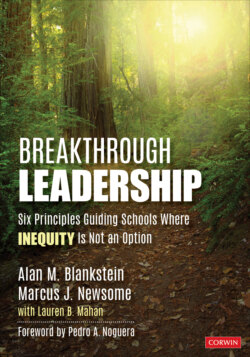Читать книгу Breakthrough Leadership - Alan M. Blankstein - Страница 6
На сайте Литреса книга снята с продажи.
ОглавлениеForeword
Pedro A. Noguera, PhD Dean, Rossier School of Education University of Southern California
Inequality in wealth and income is increasing throughout the world, and as it does, our ability to address many of our most pressing problems—poverty, global migration, and climate change—worsens and solutions remain beyond our reach.
As inequality grows, so do resentment and frustration. More and more Americans realize that their children may not have access to the same kinds of opportunities that were once available to them: stable jobs with good health benefits, a home that they own, or paying for a college education without becoming saddled with years of debt. The so-called American Dream has become a faint and distant memory, and as it fades, desperation increases.
Additionally, at the time of this book’s publication, we find ourselves grappling with two crises: a pandemic that has infected a greater percentage of the United States population than in any other nation on earth, and a social movement for racial justice that has swept the country even more quickly than the pandemic, aimed at undoing years of deeply embedded structural racism that is manifest in every aspect of life.
For many years, research has shown that education can serve as a resource for addressing many of the problems facing modern societies. This includes economic and social inequality, as well as racism, bigotry, and ignorance. However, more often than not, individuals and communities that need education to improve their lives are the least likely to receive the kind of education that makes progress possible. That is, rather than advancing equality and opportunity, too often education has been implicated in the reproduction of inequality.
The critical variable that determines whether or not our schools can respond adequately to the numerous challenges that they and their children face is leadership. Particularly given our lack of leadership at the national level, educational leaders must step forward to provide the vision and strategies needed to promote equity in educational opportunities and outcomes.
This book is about the work of such leaders. In big cities, small towns, and rural areas, a small number of principals and superintendents are showing that progress can be made when leaders have the resourcefulness and courage to address equity challenges directly.
For the last several years, the United States has embraced educational reforms that rely on standardized testing and competition to promote accountability, while ignoring the need to provide impoverished and underdeveloped communities with adequate resources to pay educators fair salaries and improve conditions in schools. Despite the lofty promises made by reformers, we now have clear evidence that the reforms we have pursued have not led to educational improvement on a large scale.
There is an alternative, and it is described in vivid detail in this book. When educational leaders adopt an equity-centered approach, they work to ensure that conditions conducive to good teaching and learning are in place.
While it would be most helpful if an equity-based approach to education reform were embraced by policymakers, we cannot afford to wait. As you will see in the pages ahead, there are educational leaders who are making significant progress at the school and district level by committing to strategically develop the professional capacity of teachers and the institutional capacity of schools to respond to student needs. Capacity building is a process that over time makes it possible for the skills of teachers to be in alignment with the needs of students. This mismatch in skills and resources is at the base of many of the challenges facing schools. With a commitment to capacity building and a clear understanding of how to carry it out in particular schools, educational leaders are moving forward in creating an environment where all children can learn at high levels.
From poverty to crime, from environmental degradation to economic underdevelopment, we have clear and compelling evidence that as societies make advances in education, many of these problems can be addressed. Educational leaders who succeed in advancing equity and serving the needs of all their students are finding ways to pursue excellence and equity by creating conditions in schools that address the academic and nonacademic needs of children (health, nutrition, safety, etc.). The educational leaders profiled in this book have a clear sense of how to systematically build the capacity of teachers and schools to meet the needs of the students they serve. I urge other leaders to learn from them so that, rather than being the exception, great schools that serve all children well will be the norm.
Reference
Ryssdal, K. (2012, June 6). Economist Joseph Stiglitz on income inequality in the U.S. In Marketplace. Minnesota Public Radio. https://www.marketplace.org/2012/06/06/economist-joseph-stiglitz-income-inequality-us/
